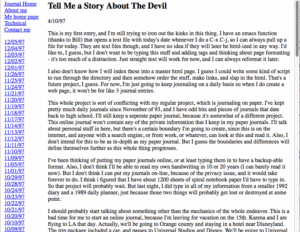I had to rip a few CDs last week, which is a rare occurrence these days. I don’t even have a CD player at this point, and have to dig up an external optical drive for my Mac once or twice a year when this happens. It had me thinking about the rise and fall of CDs in my life, which brought me back to my first CD player ever, the Toshiba XR-J9.
So, 1987. The Compact Disc was released in Japan five years before, and audiophiles had been buying them in the US, but not so much in Elkhart, Indiana. The whole idea of digital audio was a thing of awe, total science fiction. Lasers! The ones and zeroes captured in the studio remained ones and zeroes until right before they hit your ears, with no degradation, no distortion, no mangling through resistance-bearing wires and analog amps. Some magazine article said if you dubbed a cassette from a CD, your copy would sound better than the professionally-duplicated one you bought in a store. I can’t even remember the first time I actually heard or touched a CD, and didn’t know anyone who had a player. I had to have one, of course. But I couldn’t spend a grand on a Sony home player, and didn’t really have the stereo to match, which would cost a few thousand more.
At that time, I had a Soundesign stereo, probably from Wards or Sears, which had tower speakers, sat in a wood rack with glass doors on the front, and was a single piece for the receiver, EQ, and double tape deck, but had grooves in the plastic face so it looked like a stack of individual components. It wasn’t exactly high fidelity, but it was better than the Sears all-in-one I had in grade school and junior high. And it had a pair of RCA connectors for Aux In, tempting me to add more.
I was out of the house more than I was in it back in high school, so cassette was my primary medium. In my pedestrian days, I ran through $20 Walkman clones on a regular basis, whatever I could pick up at Osco Drugs on a discount. Once I graduated to a car, it had a no-name tape deck in it. For a while, I would buy vinyl and record them to tapes, but I mostly bought cassettes, or dubbed friends’ albums onto blanks.
Every time I went to any store with audio gear, I’d ogle the various components, thinking about how someday when I was out of college and rich, my first priority (aside from a Commodore Amiga) would be to buy some esoteric system with gigantic speakers, two dozen bands of EQ, a DAT digital tape deck (what happened to those?), and of course a reference-quality CD player. There was a store in the Concord Mall called Templin’s that was half instruments, half audio gear. (Oddly, they also sold Atari home computers.) This was the place where they had separate listening rooms where you could go in and see full setups like the one in American Psycho, thousands of dollars of gear that was absolutely unobtainable to me.
In the summer of 1987, I started working my first “real” job at the Taco Bell across the highway from the Concord Mall. And right around then, CD player prices started dropping. They were like $1000, then hit $500, then $400 or $300. And around the time my first paycheck hit my pocket, I was in the K-Mart across the street from my ‘Bell, and there was this CD player that was a hundred dollars. I absolutely had to buy in, and I did. (For reference, $100 in 1987 is about $285 now. I made $3.35 an hour dealing with drive-through abuse and refried bean cooking at TB.)
The XR-J9 was an odd little beast. It was about twice the size of a battery-powered Sony Discman of that vintage, but way smaller than a component home CD player. It was a weird mix of the two, though. Like a Discman, it was a top-loader; you popped open a lid and put the disc directly on a hub, then closed the door to get the laser to start. (Laser! I now owned a Class 1 laser! 3-beam pickup, whatever that means! It even had a warning label on the bottom!)
Unlike the portable Discman, the Toshiba ran on mains only, with no provision for a battery. It also had a fixed set of RCA cables coming from the back, which would plug into a home receiver. It also had a headphone jack and volume slider on the front, but unless you had a Honda generator with you, it was in no way portable. And those cables weren’t removable, which bugged me.
The controls were spartan: a power button on the front; the usual play, pause, forward, and back buttons. You pressed in a corner of the lid and then it unlatched and popped open. It also had a Display button, which I think toggled the time versus the time remaining that showed on the small LCD display. Some buttons had multiple functions. If you pressed Forward once, it would skip a track; hold it and it would fast-forward through the track, playing a sliver of sound every five seconds. This was amazing coming from the tape world, because I swear I spent half my batteries jumping around tapes, and this was instant. Random access! There was also some elaborate combination of buttons you could mash to access a “memory” mode where you could program up to 16 tracks in any order to get a custom playlist, which was a huge pain in the ass to do, and then it immediately went away when you opened the player. I would very occasionally do this when listening to The Police – Synchronicity so I could skip track 4 (“Mother”) because I never felt like it matched the rest of the album. (Now I think it’s the best track.)
The obvious problem after sinking a whole paycheck into this thing was that I now needed music. I think at that time, a tape was like $7.99 and an LP was $9.99, but a CD was $15.99. Each title was an investment. I went to Super Sounds, my favorite record store ever in the Concord Mall, and went A-Z through their three or four racks of CDs, trying to figure this one. (At that time, CDs were in “long boxes” which were the same height and half the width of an LP, so stores could use the same vertical racks for the new format.)
My first purchase was the most recent Iron Maiden album, Somewhere in Time. I was way too into Maiden at the time, and this album was a perfect storm for me: it was Iron Maiden; it had this futuristic cyberpunk theme; it was what I thought at the time was super-modern, ultra-technical sounding; it was digitally mastered; it was Iron Maiden; it was loud, but precise. It was also almost an hour long, so it was like twice as long as if I’d just bought a Boston album or whatever. I remember bringing the CD home, listening to the whole thing on headphones, and there was this one part on the song “Deja-Vu” where Nicko McBrain is playing this snare volley right before the chorus comes back in, and I could suddenly hear that he was also tapping out time on the hi-hat, which wasn’t audible on the cassette. It absolutely blew my 16-year-old mind.
Of course, I had no more money, so I had to go sling tacos and wait two more weeks to get something else. I don’t remember why, but I got the ELP album Trilogy next. A headphone listen also bewildered me. The first song starts with a beating heart, then Emerson doodling away on keyboards, which sounded incredibly crisp, compared to a muddy cassette. After two minutes, the rest of the band suddenly came crashing in, and the dynamic range demonstrated by the sudden change was incredible.
I can’t remember what was the third disc, but I did waver on whether I wanted the high quality of a CD or having twice as many at-bats by sticking to tape. By that fall when I started working at Wards and moved to weekly paychecks, I vowed to myself that I’d buy a tape every week, if not more. I pretty much stopped buying CDs for a while, until maybe my senior year, when I discovered the Columbia House and BMG CD clubs.
About twenty years later, the CD thing came to an end, with just shy of a thousand titles in my collection. I’d slowly been ripping things to MP3 when the 21st century started. Once the iPod hit, CDs became a temporary medium I used until I could rip the tracks to a hard drive, then became a backup in storage in case my computer died. On November 22, 2005, I made my first purchase on iTunes, and that was the beginning of the end. Now, almost everything is added from Apple Music or bought from Bandcamp.
(Oddly enough, the first track I ever bought online was Harry Nilsson’s “Remember.” The reason I suddenly needed to hear it again was a memory of the Michiana student TV show Beyond Our Control, which closed each episode with the song.)
That Toshiba lasted until maybe 1992, when it mysteriously died, stopped loading up discs. I bought a Kenwood portable player that summer (this was described in Summer Rain) and that unit suddenly became my main CD player for a few years until I bought a Kenwood 6+1 changer at the start of 1994. The Kenwood portable never really got used as a portable, because it drained AA batteries so fast, and this was before the anti-skip memory thing was out, so it was fairly useless on the go. I never considered CD as a portable medium, using the MiniDisc from the late 90s until the iPod showed up. I didn’t own a car with a CD player until 2007, when the format was dead. My 2014 car had a CD player that I think I used once. I honestly could not remember if my 2025 car even has one, and I guess it doesn’t.
All of this is so strange to think about, because that 1987 dream of someday having a gigantic reference system in my home is long gone. (So’s that desire for a new Amiga, but that’s another story.) MP3 wasn’t even a dream back then. I listen to 99% of my music on AirPods these days. I don’t have a room full of racks of CDs. I could afford to go buy any stereo I want, but what would I even buy? I bought a pair of near-field monitors for my desk literally a month before the pandemic started and I had to go to pure headphones for the locked-in-the-same-apartment 24/7 thing. I think I have two different Kenwood receivers in storage, and use a $200 sound bar in the living room for the TV. Music is still important, and I’m listening to stuff every day. But the technology has changed and the meaning of where it is in my life has too. Is that good or bad?








